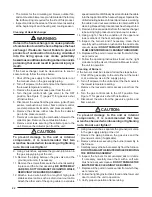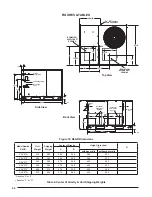
11
Acoustical Duct Work
Certain installations may require the use of acoustical
lining inside the supply duct work.
• Acoustical insulation must be in accordance with the
current revision of the Sheet Metal and Air Conditioning
Contractors National Association (SMACNA) application
standard for duct liners.
• Duct lining must be UL classifi ed batts or blankets with
a fi re hazard classifi cation of FHC-25/50 or less.
• Fiber duct work may be used in place of internal duct
liners if the fi ber duct work is in accordance with the
current revision of the SMACNA construction standard
on fi brous glass ducts. Fibrous duct work and internal
acoustical lining must be NFPA Class 1 air ducts when
tested per UL Standard 181 for Class 1 ducts.
UNIT INSTALLATION
Packaging Removal
Remove the shipping carton and User’s Manual from the
equipment. Take care not to damage the tubing connections
when removing the carton. For rooftop installations, remove
and discard the two supports attached beneath the unit.
Rigging and Hoisting
WARNING:
To avoid the risk of property damage, personal
injury, or death, it is the rigger’s responsibility
to ensure that whatever means are used to hoist
the unit are safe and adequate:
• The lifting equipment must be adequate for the
load. Refer to Table 9 (page 24) for unit weights.
• The unit must be lifted from the holes in the
base rails using cables or chains.
• Spreader bars are required to protect the unit
and ensure even loading.
• Keep the unit in an upright position at all times.
The rigging must be located outside the units
center of gravity. Refer to Figure 10 (page 24)
for locating the center of gravity.
• All panels must be securely in place during
rigging and hoisting.
Clearances to Combustible Materials
R6GD units are certifi ed as combination heating and
cooling equipment for outdoor rooftop or ground level
installations. Units may be installed on combustible
fl ooring or Class A, B, or C roofi ng material when used
with bottom supply and return air ducts as long as the
following requirements are met:
• If using horizontal supply and return air ducts, the
horizontal roof curb kit and return air kit must be installed
prior to unit installation. Horizontal roof curb is required.
• If using bottom discharge with return air ducts a roof curb
must be installed prior to unit installation. See Rigging
and Hoisting section for setting of the unit.
• Suffi cient clearance for unobstructed airfl ow through
the outdoor coil must also be maintained in order to
achieve rated performance. See page 7 for information
about locating the equipment.
Ground Level
Ground level installations must be located according to
local building codes or ordinances and these requirements:
• Clearances must be in accordance with those shown
in Figure 2 (page 7).
• A suitable mounting pad (Figure 4, page 12) must be
provided and be separate from the building foundation.
The pad must be level to ensure proper condensate
disposal and strong enough to support the unit’s weight.
The slab height must be a minimum of 2” (5cm) above
grade and with adequate drainage.
• Units require horizontal roof curb and return air kit for
horizontal installations.
• Ductwork should be attached directly to fl anges on
panels supplied in horizontal duct conversion kits.
Rooftop
Rooftop installations must be located according to local
building codes or ordinances and these requirements:
• The roof must be capable of handling the weight of the
unit. For unit weights, see Table 9. Reinforce the roof if
necessary.
• The appropriate accessory roof curb (Figure 5, page 12)
must be installed prior to unit installation. The roof curb
must be square and level to ensure proper condensate
drainage. Please follow all instructions provided with
the kit.
• Secure roof curb or frame to roof using acceptable
mechanical methods per local codes. NOTE:
Make sure
the two supports beneath the unit have been removed.
Condensate Drain
Condensate is removed from the unit through the 3/4”
female pipe fi tting (Figure 6, page 12) located on the front
side of the unit. Install a 2 inch condensate trap in the
drain line of the same size and prime with water. When
connecting rigid drain line, hold the female fi tting with a
wrench to prevent twisting. Do not over tighten! Refer
to local codes and restrictions for proper condensate
disposal requirements.
Horizontal to Downfl ow Conversion
The unit is shipped ready for horizontal duct connections.
If down fl ow ducts are required, the unit must be converted
following the steps below for both the supply and return
ducts.
1. Remove the horizontal duct cap.
2. Locate the duct cap inside the duct openings and
remove the screw holding it in place.
3. Lift the cap out of the unit. (Hint: The cap can be pushed
up from the bottom by reaching through the fork slot).
4. Cover the horizontal duct opening with the horizontal
duct cap. The insulation will be on the indoor side.
5. Fasten the cover with screws to seal.












































